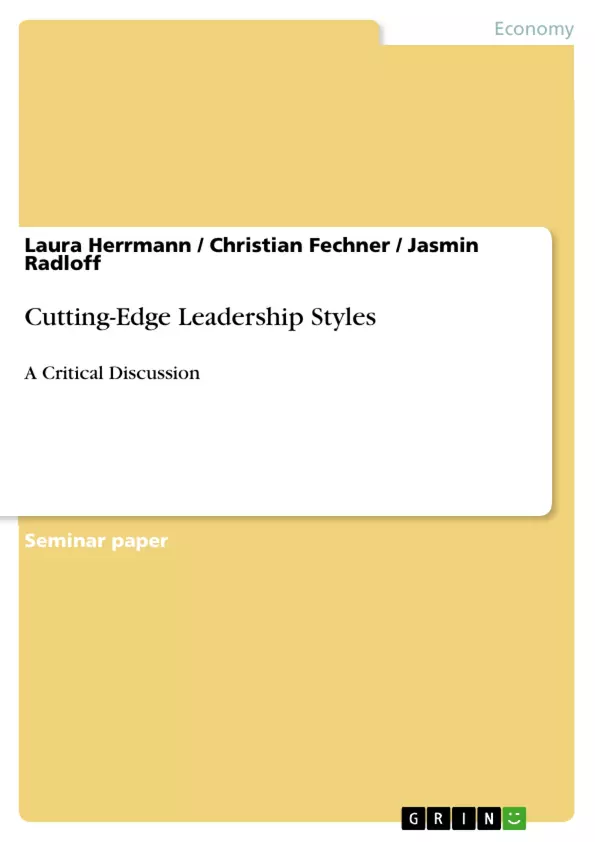Leadership is not a "one size fits all" thing. Often, leaders must adapt their style to fit a situation or a specific
group. Therefore, it is useful to gain a thorough understanding of the cutting-edge leadership styles. Cutting edge leadership styles are advancements of other leadership style to meet the requirements of a business which becomes more and more speeded up. Four different styles will be analyzed: The situational, charismatic, visionary and supportive leadership style. The situational one focuses on the maturity level of the follower and the leader
can decide between four approaches which fit the most to the maturity level. The charismatic leadership style is
more or less a nature given talent which cannot be trained. The leader needs to have the talent to deal with people
in a very special way to motivate them, especially in critical situations. By practicing the supportive leadership
style the leader’s behavior expresses concern for the followers and their individual needs and each follower is
considered individually. The visionary leadership style is supposed to transmit energy to the employees by giving
them a sense of hope and confidence in achievin a certain vision. But all in all there is no right or wrong leadership style and it needs to fit to the follower, the situation as well as to the leader. Also a good leader varies with many different leadership styles because every situation has its peculiarities and needs handled always differently.
Inhaltsverzeichnis (Table of Contents)
- Introduction
- Effectiveness of Innovative Leadership Styles
- What Makes a Good Leader?
- Leadership Style
- Cutting-Edge Leadership Styles
- Charismatic Leadership
- Defining Charisma
- Communication & Conversation of Charismatic Leaders
- Managing a Team
- Managing Decisions
- The Approach of Charismatic Leaders
- The Combination of Charismatic-Transformational Leadership
- Result
- Situational Leadership
- Advantages
- Disadvantages
- Supportive Leadership
- Coaching
- Mentoring
- What Does a Supportive Leader Need?
- Visionary Leadership
- Charismatic Leadership
Zielsetzung und Themenschwerpunkte (Objectives and Key Themes)
This paper explores the effectiveness of different cutting-edge leadership styles in today's business world. It aims to provide an overview of modern leadership approaches and identify the specific contexts in which they are most effective. The paper examines the situational, charismatic, supportive, and visionary leadership styles, highlighting their strengths and weaknesses. Key themes explored include:- The importance of adapting leadership style to specific situations and individuals
- The qualities and skills required for effective leadership
- The evolution of leadership styles to meet the demands of modern workplaces
- The role of communication, motivation, and team management in different leadership styles
Zusammenfassung der Kapitel (Chapter Summaries)
The introduction lays out the significance of leadership skills in today's rapidly changing world. It emphasizes the need for flexible leadership approaches that can adapt to diverse contexts and demands. The chapter defines leadership and distinguishes it from management, highlighting the broad spectrum of leadership styles that have emerged in recent years.
The chapter on “Effectiveness of Innovative Leadership Styles” discusses the importance of selecting the appropriate leadership style for different situations. It delves into the characteristics of effective leaders, including emotional intelligence and self-awareness. The chapter also highlights the role of self-insight, self-regulation, and motivation in successful leadership.
The chapter on “Charismatic Leadership” examines the nature and impact of charisma in leadership. It explores how charismatic leaders communicate, manage teams, and make decisions. The chapter also discusses the combination of charismatic and transformational leadership approaches.
The chapter on “Situational Leadership” focuses on adapting leadership style based on the maturity level of followers. It explores the advantages and disadvantages of this approach and provides examples of how situational leadership can be implemented effectively.
The chapter on “Supportive Leadership” discusses the role of empathy and support in leadership. It examines the concepts of coaching and mentoring and explores the qualities that define a supportive leader.
The chapter on “Visionary Leadership” examines the ability of leaders to inspire and motivate followers by communicating a clear vision for the future. It explores how visionary leadership can foster a sense of hope and confidence among team members.
Schlüsselwörter (Keywords)
This paper delves into the core concepts of leadership in modern organizations, focusing on cutting-edge leadership styles, their effectiveness, and the individual characteristics of successful leaders. Key themes include: charismatic leadership, situational leadership, supportive leadership, visionary leadership, emotional intelligence, self-awareness, communication, team management, and employee motivation.- Quote paper
- Laura Herrmann (Author), Christian Fechner (Author), Jasmin Radloff (Author), 2012, Cutting-Edge Leadership Styles, Munich, GRIN Verlag, https://www.grin.com/document/232426



